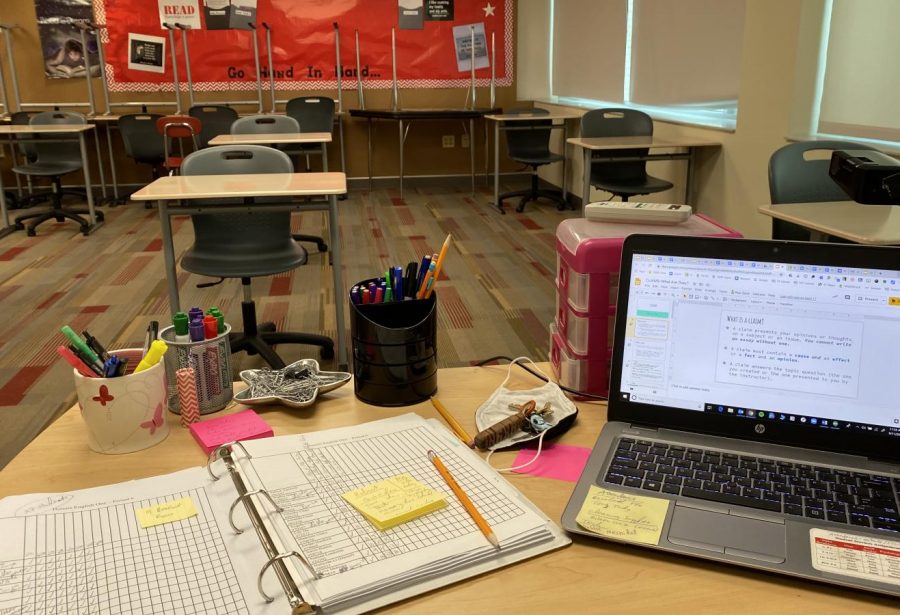Column: The Quest for Normalcy and why e-learning isn’t working
Photo courtesy of Maxyne Granatelli
Teachers are being encouraged to teach from their classrooms to help foster a sense of normalcy, but the absence of students from classrooms is hardly normal. District 203 does not give teachers the option to teach completely from home.
September 11, 2020
This year has gotten off to a… rocky start. With this new, more synchronous form of e-learning came hopes for a more personal, engaging form of instruction. However, it seems the general first impression is that it’s a complete and utter disaster. I don’t blame the district or teachers for the system they devised, but we need to review the approach with a critical eye.
Let’s talk about it.
The most obvious issue is pretty apparent: it’s just too much Zoom, man. Trying to focus on your screen and learn for upwards of 7-8 hours a day is an exhausting process, mentally and physically. Headaches come often and eyeballs suffer at the mercy of the dispassionate screen. Add onto this the omnipresent, passive self-doubt that comes from being on camera constantly (Am I being looked at? Am I out of frame? Is there something in frame that shouldn’t be? Did my webcam just fall a little bit? Is my virtual background breaking again?) and you have the perfect recipe for a system that doesn’t actually improve learning over an asynchronous one.
The system is unhealthy in a different way, though. It’s disorientating. No longer do you move through school. Rather, school moves around you. We’re all just dreamily floating from class to class, with not much available time for anything resembling physical motion. It’s shockingly hard to care or feel engaged when you’re not really there.
It’s an especially odd feeling when school ends. One second you were fighting through your gauntlet of virtual classes, and the literal next second you’re free to do whatever you wish. The barrier between school and life has been curb-stomped, an uncomfortable truth that makes rest and relaxation hard to come by afterward.
This hits those who normally spend much of their free time on their computer (ex: ya’ boy) the hardest. For them, their daily schedule is suddenly total computer overload. The previous problem of mentally separating school from freedom is also made exponentially worse for them.
There’s more unfairness to be had. Grading policies have returned to those used prior to the March school shutdown. This, to me, is ridiculous. To pretend that what I’m doing this year is equivalent to any other and should be represented in the same way is absolute nonsense. It simply is not the same. Beyond this, it is a slap in the face to those with home environments not conducive to privacy and long stretches of quiet focus, or those who don’t learn effectively online. Countless students are set up for failure, and to hand them letter grades is borderline disrespectful.
There was a critical mindset error in the creation of this system: the Quest for Normalcy. The district and several teachers are laser-focused on recreating in-person school within the homes of thousands of children. It’s why we attend all of our classes every day on the regular bell schedule. It’s why we’re thrown in breakout rooms to try and collaborate with each other (it doesn’t work like you’d think — it’s an incredibly awkward experience, one that leads to most people ignoring each other and flying solo instead). It’s why we’re handed letter grades.
One teacher had the unrivaled audacity to tell me not to eat or drink… in my own home. I don’t want to sound revolutionary, but you physically cannot stop us from doing so, or interacting with our pets, or talking with family members. In this new virtual environment, the education system finally has the chance to acknowledge its students as breathing human beings with bodily needs, yet there’s a bizarre and disturbing emphasis on enforcing the Old Ways. P.S.: I will neither confirm nor deny if I’m wearing pants.
The Quest for Normalcy is actively unproductive at best, but it’s legitimately destructive at worst. Case in point, what might be the most egregious and baffling decision I’ve ever seen the district make: forcing teachers to teach in their classrooms multiple days a week, with no contingencies for those who are more vulnerable or seemingly any thoughts given about the health of the staff.
Here’s my question to you: Is this a good thing for elderly teachers? For anyone, objectively? What you may find, shockingly, is that it is actually universally a bad thing. I understand you want kids to feel “at school,” but as a kid, I can speak for myself and others that it actually doesn’t do that. I’m worried for our staff. They don’t deserve this.
With all of this said, how do I think it can be improved, given that the year is already going? It’s simple, really:
- Keep the daily Zooms, but make them optional, and have teachers post them after each class period for students who decide not to attend. This will attend to the needs of both those who need direction and those who can function asynchronously perfectly well.
- Cut the amount of classes per day in half. Even with optimal zooms, requiring them all to be watched every day is still far too much.
- Make grades pass-fail. It didn’t work before because kids had a standing grade that couldn’t be changed, but with nothing for students to fall back on, emphasizing completion and effort over results will enable real learning.
- Let teachers teach from the comfort and safety of their own homes, giving them peace of mind and not jeopardizing their lives for literally no reason.
We’re in a pandemic. This isn’t normal. It can’t be. Let’s stop pretending it is.









Jessica Hart • Sep 15, 2020 at 12:47 am
So insightful! Thank you for speaking your mind & doing it so eloquently. As a parent of a new freshman, I found this to express some of my own personal thoughts too. It also opened my eyes to some struggles I may not have realized existed for my student but that I will be more understanding of now. These are new waters for us all; I commend you for speaking from your position and offering some great solutions.
Ms B • Sep 11, 2020 at 9:44 pm
Thank you for sharing. I have two teens and they feel the same way.
Mrs. Lundquist • Sep 11, 2020 at 5:40 pm
Absolutely fabulous column, Braden! Spot on! Thank you for sharing you thoughts and your concerns!
Mrs. L